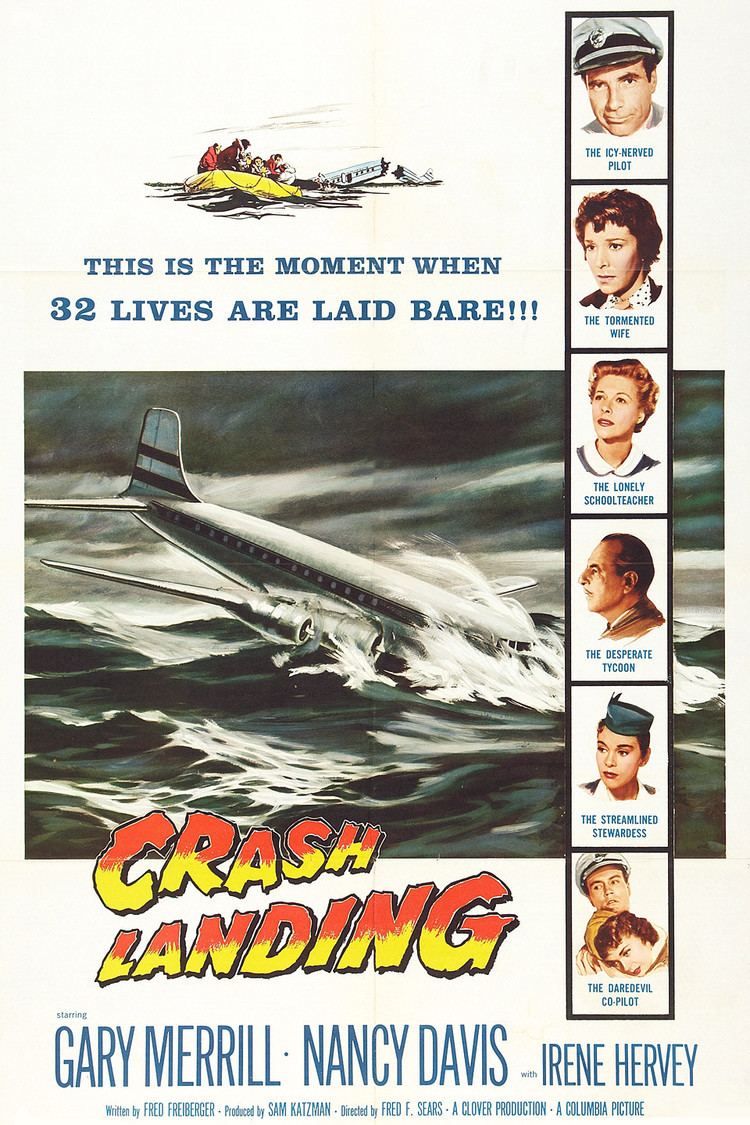5.4 /10 1 Votes5.4
Narrated by Uncredited Director Fred F. Sears | 5.4/10 IMDb Produced by Sam Katzman Music by Mischa Bakaleinikoff Initial release 1958 Music director Mischa Bakaleinikoff | |||||||||||||||||||||||||||||||||
 | ||||||||||||||||||||||||||||||||||
Starring Gary MerrillNancy DavisIrene Hervey Cast Similar Movies about flight, Disaster movies, Movies about pilots | ||||||||||||||||||||||||||||||||||
Crash Landing (aka Rescue at Sea) is a 1958 dramatic, "disaster" film directed by Fred F. Sears, starring Gary Merrill and Nancy Reagan. This was the last film in which Nancy Reagan (billed as Nancy Davis) appeared, though she continued to work in television for some years thereafter. Crash Landing was based on Pan Am Flight 6, a real-life ditching at sea.
Contents
Plot
Transatlantic flight 627 Captain Steve Williams (Gary Merrill) is piloting a DC-7C commercial airliner on a flight from Lisbon to New York when two engines fail. One of the propellers cannot be feathered, causing drag that makes it uncertain whether New York can be reached. The crippled aircraft is not the only concern for Williams as he has been faced with family complications. He is at odds with his wife Helen (Nancy Davis) over raising their son. Williams is also not liked by his co-pilot John Smithback (Roger Smith), engineer Howard Whitney (Sheridan Comerate) and navigator Jed Sutton (Richard Newton) who resent his overbearing attitude.
The other crew and passengers have a variety of concerns. They include Teddy Burton, a child on the flight whose dog Wilbur is in the rear cargo area of the airliner. Bernice Willouby (Irene Hervey) is an anxious flyer, while first-class passenger Maurice Stanley (Lewis Martin) has been recently widowed. Businessmen Arthur White (Richard Keith) and Calvin Havelick (Hal Torey) are feuding with each other. Stewardess Ann Thatcher (Jewell Lain) considers the co-pilot's advances unwelcome, but has to work with him.
At the fail-safe point, Williams radios to a nearby U.S. destroyer for help, and alerts everyone on board to ready themselves for a crash landing at sea. As they prepare for the ditching, the pilot realizes that landing at night is too perilous, and they circle until sunrise. During the delay Williams realizes that his attitudes have been too harsh and Ann Thatcher reconsiders her attitude to the co-pilot. When the airliner hits the water, the passengers, who are violently tossed about, recover and climb out to deployed life rafts. All are saved, and Williams rescues the dog, which he had previously told the boy would have to be abandoned. Eventually Williams reunites with his wife and son in Lisbon.
Production
Prolific B-Movie director Fred F. Sears had been renowned for "quickies", films that were shot on tiny budgets and often worked on a number of projects at once, from feature films to television shows. After his death in 1957, Crash Landing (originally known by the working title "Rescue at Sea") was one of five films that were finished but remained unreleased for a year.
Production for Crash Landing began on August 6, 1957, and wrapped in 10 days, with both studio and location photography completed in the typical Sears fashion. Principal location photography took place at the Hollywood Burbank Airport, playing the part of Lisbon Airport. The aircraft seen in the film include a United Airlines Convair CV 240 and Douglas DC-6 as well as DC-6s from American Airlines and Western Airlines. The principal airliner featured in Crash Landing was a Douglas DC-7C, seen in miniature and in stock footage.
Reception
Crash Landing was an early disaster film, that had its antecedents in The High and the Mighty (1954). Following some of the now-familiar plot devices in disaster films, as a recent review by Jeff Stafford noted, "There’s also plenty of drama going on in the passenger section with an assortment of disagreeable and problematic travellers caught up in their own personal crisis." Stafford further described the climatic crash as "As for the final splashdown in 'Crash Landing', it’s bound to be a disappointment for most considering the big dramatic buildup to it, but did you really expect much from a Sam Katzman-Fred F. Sears production? A miniature model airplane, some jerky camera movements, a water tank and some intensely dramatic music, courtesy of composer Mischa Bakaleinikoff ..."
Released
Crash Landing was released on a double bill with Going Steady (1958).
